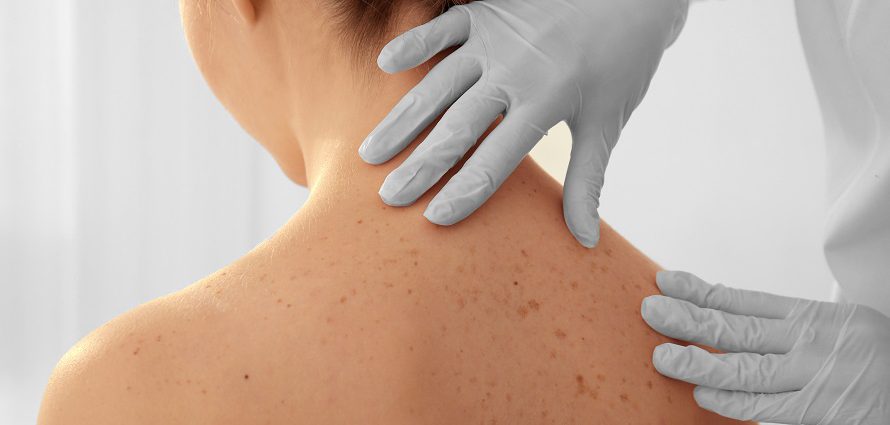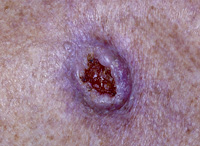Skin Cancer Surgery: Important Decisions

Reviewed by Darrick E. Antell, MD
Skin cancer is the most common form of cancer in the United States, with more than one million cases diagnosed annually, according to the Skin Cancer Foundation. One in five Americans will develop skin cancer in their lifetime.
Fully 80 percent of skin cancers occur on the face, head or neck – the areas that tend to get the most sun. If these epithelial tumors are not removed carefully, they can be disfiguring as well as lethal. Board certified plastic surgeons and dermatologists are the specialists with the most experience and expertise when it comes to removing skin lesions and reconstructing the wound site.
Skin cancer tumor removal is one of the most common types of reconstructive plastic surgery. There were 4.9 million reconstructive surgical procedures performed in 2008, according to the American Society of Plastic Surgeons. Of these, more than 3.2 million were skin cancer tumor removal surgeries.
Skin Cancer Types

There are three main types of skin cancer.
Basal cell carcinoma occurs in the basal cells (small, round cells in the base of the outer layer of skin). This treatable carcinoma is the most common type of skin cancer.
Squamous cell carcinoma occurs in the squamous cells (flat cells that form the surface of the skin). Actinic keratoses (rough, scaly, slightly raised growths that range in color from brown to red and from about 1 mm to 1 inch in diameter) may be the earliest form of squamous cell carcinoma. These cancers are also considered extremely treatable.
Melanoma is a potentially fatal skin cancer that forms in melanocytes (skin cells that make pigment). Melanoma accounts for about 8,110 of the 10,850 skin cancer deaths each year, according to the American Cancer Society. If caught early and treated aggressively, melanoma can be cured.
Skin Cancer Treatment and Tumor Removal
Skin cancer treatment is often a more involved process than the simple removal of the visible lesion. Surgeons must also remove subdermal cancerous tissue underneath the growth to make sure that they get all of the cancer cells.
To do this, your plastic surgeon may order a frozen section in which the cancer is removed and microscopically examined by a pathologist before closing. This helps assure that he or she has gone deep enough, and removed all of the cancerous cells. In clinical terms, this success is called a “clear margin.” Your plastic surgeon must continue to excise tissue until the entire region has a clear margin. When clear margins are found, the surgeon can reconstruct the wound.
Skin Cancer Removal Types
There are many types of surgery to remove skin cancers from your body.
In some cases, a plastic surgery specialist may cut the tumor from the skin along with some of the normal skin around it.
During Mohs surgery, the tumor is cut out layer by careful layer. The surgeon views each layer through a microscope to check for cancer cells. He or she will continue to remove layers until there is a clear margin. Mohs surgery is often used to remove skin cancers on the face.
Other skin cancer removal surgeries include:
Shave excision. During this procedure, your surgeon shaves the tumor off of the skin with a small blade.
Electrodesiccation and curettage. This procedure involves cutting the tumor from the skin with a sharp, spoon-shaped tool (curette) and zapping the area with a high-frequency electric current to stop the bleeding and destroy any remaining cancer cells.
Cryotherapy. This procedure involves freezing and destroying skin cancer.
Lasers. Certain lasers may destroy and vaporize skin cancer tissue.
Dermabrasion. This procedure involves the use of a wire brush or a diamond wheel with rough edges to basically sand off the upper layers of the skin. This is a much more aggressive form of the common anti aging treatment known as microdermabrasion.
Your surgeon will choose the most appropriate surgical treatment based on the size, location and type of your skin cancer. After surgery to remove the cancer, reconstruction of the wound site may be needed. Scars are usually cosmetically acceptable when small skin cancers are removed. If the tumors are very large, however, a local flap that repositions the adjacent tissue over the wound may be needed. A skin graft, in which healthy skin is removed from one area of the body and relocated to the wound site, may also be needed after skin cancer removal surgery.
Some forms of skin cancer may also require additional treatment such as radiation therapy (radiotherapy) and chemotherapy to prevent spreading, and make sure any errant cancer cells are destroyed.
Skin Cancer Risks and Prevention
Most of the one million (plus) cases of non-melanoma skin cancer diagnosed yearly in the United States are considered to be sun-related, according to the American Cancer Society.
Excessive exposure to the sun and its ultraviolet (UV) rays can cause skin cancer. Getting sunburned or tanned in childhood more than doubles the chances of developing potentially fatal melanoma later in life. People with light skin are much more likely to have sun damage, and are at greater risk of developing skin cancer than their darker-skinned counterparts.
Prevention and sun safety are the best ways to stave-off skin cancer. The Skin Cancer Foundation suggests:
- Seeking the shade,especially between 10 A.M. and 4 P.M.
- Avoiding burns.
- Avoiding tanning and UV tanning booths.
- Using sunscreen with a sun protection factor (SPF) of 15 or higher every day
- Applying one ounce (two tablespoons) total of sunscreen to all exposed areas, 30 minutes before going outside. Reapply every two hours or immediately after swimming or excessive sweating.
- Covering up with clothing, including a broad-brimmed hat and UV-blocking sunglasses. Your eyeglasses should block 99 percent to 100 percent of UVA and UVB radiation. Check the label.
- Keeping newborns out of the sun and using sunscreens should be used on babies over the age of six months.
- Examining your skin from head-to-toe every month.
- Seeing your physician every year for a professional skin exam.
Vitamin “D”ilemma:
Sunscreen protects us from skin cancer, but also blocks vitamin D from reaching our skin
Exposure to the sun’s ultraviolet rays is a known risk factor for skin cancer, and that’s the No. 1 reason we all slather on sunscreen. The one downside to this healthy habit may be that we are missing out on vitamin D.
Vitamin D is often called “the sunshine vitamin” because we make it when exposed to the sun. It doesn’t take much time in the sun — just 10 to 15 minutes a day — for us to make all the vitamin D we need to help our bones better absorb calcium. Producing too little vitamin D has been linked to autoimmune diseases, heart disease, diabetes and certain forms of cancer.
So how can you protect your skin, but also bone up on your D? Talk to your doctor about a blood test to see where you stand. If you are vitamin D deficient, supplements may help. The Institute of Medicine recently changed their vitamin D recommendations. They now suggest that everyone aged 1 to 70 consume 600 International Units (IU) of vitamin D per day, and that adults older than 70 aim for 800 IU per day. Foods rich in vitamin D include cod liver oil, salmon, sardines, eggs, liver, beef, and vitamin D-fortified milk, orange juice and yogurt.
About the Reviewer of This Article
Darrick E. Antell, MD, is an educational spokesperson for the American Society of Plastic Surgeons. He is a board-certified plastic and reconstructive surgeon who has been in private practice for more than 20 years in New York City. Dr. Antell is a member of the American Society for Aesthetic Plastic Surgery and the American Society of Plastic Surgeons. He is also a Fellow of the American College of Surgeons. Dr. Antell received his general surgery training at Stanford University Medical Center and his specialty training in plastic/reconstructive surgery at the New York Hospital/Cornell Medical Center and the Memorial Sloan-Kettering Cancer Center in New York City.



